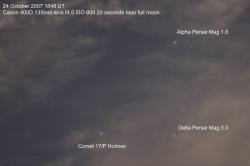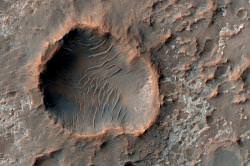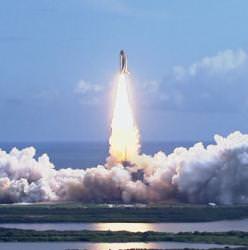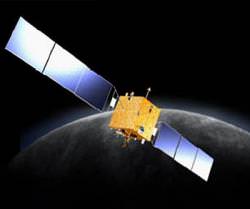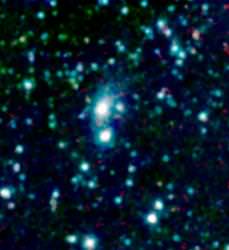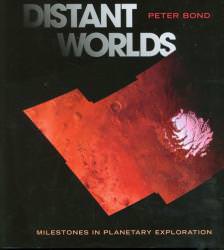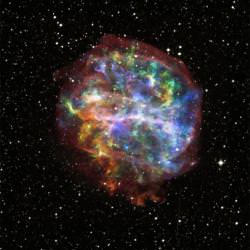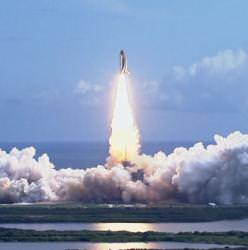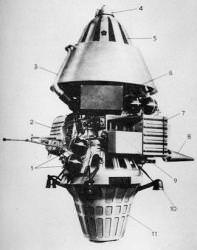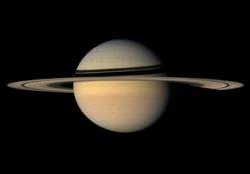Monday, October 22 – Something very special happened today in 2136 B.C. There was a solar eclipse, and for the very first time it was seen and recorded by Chinese astronomers. And probably a very good thing because in those days the royal astronomers were executed for failure to predict!Today is also the birthday of Karl Jansky. Born in 1905, Jansky was an American physicist as well as an electrical engineer. One of his pioneer discoveries was non-Earth-based radio waves at 20.5 MHz, a detection he made while investigating noise sources during 1931 and 1932. And, in 1975, Soviet Venera 9 was busy sending Earth the very first look at Venus’ surface. If you are up before dawn this morning, why not take a moment to have a look at Venus yourself. Can you tell what phase it is in through the telescope?
Also today in 1966 Luna 12 was launched towards the Moon – as so shall we be. Tonight we’ll let Gassendi be our guide as we head north to examine the ruins of crater Letronne. Sitting on a broad peninsula on the south edge of Oceanus Procellarum, this class V crater once spanned 118 kilometers. Thanks to the lava flows which formed Procellarum, virtually the entire northern third of the crater was submerged beneath the flow, leaving the remaining scant walls to rise no more than a thousand meters above the surface. While that might seem shallow, that’s as high as El Capitan in Yosemite!
Tuesday, October 23 – Tonight the Moon itself will be our starting point as we look for the planet Uranus less than 2 degrees south. Fix its position in your memory, because it will play a role in just 24 hours.
If you journey to the Moon tonight, you might return to the southern quadrant along the terminator to have a look at 227 kilometer diameter crater Schickard. Seen on the oblique, this great crater’s floor is so humped in the middle that you could stand there and not see the crater walls! Be sure to note Schickard for your lunar challenge studies.
After having looked at the Moon, take the time out to view a bright southern star – Fomalhaut. Also known as “The Lonely One,” Alpha Piscis Austrini seems to sit in a rather empty area in the southern skies, some 23 light-years away. At magnitude 1, this main sequence A3 giant is the southern-most visible star of its type for northern hemisphere viewers, and it is the 18th brightest star in the sky. “The Lonely One” is about twice the diameter of our own Sun, but 14 times more luminous! Just a little visual aid is all that it takes to reveal its optical companion…
Wednesday, October 24 – Today in 1851, a busy astronomer was at the eyepiece as William Lassell discovered Uranus’ moons Ariel and Umbriel. Although this is far beyond backyard equipment, we can have a look at that distant world, as we find Uranus just where we left it last night – only a bit further away from the Moon’s influence.
While Uranus’ small, blue/green disc isn’t exactly the most exciting thing to see in a small telescope or binoculars, the very thought that we are looking at a planet that’s over 18 times further from the Sun than we are is pretty impressive! Usually holding close to a magnitude 6, we watch as the tilted planet orbits our nearest star once every 84 years. Its atmosphere is composed of hydrogen, helium and methane, yet pressure causes about a third of this distant planet to behave as a liquid. Larger telescopes may be able to discern a few of Uranus’ moons, for Titania (the brightest) is around magnitude 14.
Thursday, October 25 – And who was watching the planets in 1671? None other than Giovanni Cassini – because he’d just discovered Saturn’s moon Iapetus. If you’re up before dawn this morning, have a look at Saturn for yourself. Iapetus usually holds around a magnitude of 12, and orbits well outside of bright Titan’s path.
Today is the birthday of Henry Norris Russell. Born in 1877, Russell was the American leader in establishing the modern field of astrophysics. As the namesake for the American Astronomical Society’s highest award (for lifetime contributions to the field), Mr. Russell is the “R” in HR diagrams, along with Mr. Hertzsprung. This work was first used in a 1914 paper, published by Russell.
Tonight let’s have a look at a star that resides right in the middle of the HR diagram as we have a look Beta Aquarii.
Named Sadal Suud (“Luck of Lucks”), this star of spectral type G is around 1030 light-years distant from our solar system and shines 5800 times brighter than our own Sun. The main sequence beauty also has two 11th magnitude optical companions. The one closest to Sadal Suud was discovered by John Herschel in 1828, while the further star was reported by S.W. Burnham in 1879.
Friday, October 26 – It’s big. It’s bright. It’s the Full Moon just before Halloween! For the next five days, let’s take a look at some of the “spookiest” objects in the night sky…
This evening we are once again going to study a single star, which will help you become acquainted with the constellation of Perseus. Its formal name is Beta Persei and it is the most famous of all eclipsing variable stars. Tonight, let’s identify Algol and learn all about the “Demon Star.”
Ancient history has given this star many names. Associated with the mythological figure Perseus, Beta was considered to be the head of Medusa the Gorgon, and was known to the Hebrews as Rosh ha Satan or “Satan’s Head.” 17th century maps labeled Beta as Caput Larvae, or the “Specter’s Head,” but it is from the Arabic culture that the star was formally named. They knew it as Al Ra’s al Ghul, or the “Demon’s Head,” and we know it as Algol. Because these medieval astronomers and astrologers associated Algol with danger and misfortune, we are led to believe that Beta’s strange visual variable properties were noted throughout history.
Italian astronomer Geminiano Montanari was the first to record that Algol occasionally “faded,” and its methodical timing was cataloged by John Goodricke in 1782, who surmised that it was being partially eclipsed by a dark companion orbiting it. Thus was born the theory of the “eclipsing binary” and this was proved spectroscopically in 1889 by H. C. Vogel. At 93 light-years away, Algol is the nearest eclipsing binary of its kind, and is treasured by the amateur astronomer because it requires no special equipment to easily follow its stages. Normally Beta Persei holds a magnitude of 2.1, but approximately every three days it dims to magnitude 3.4 and gradually brightens again. The entire eclipse only lasts about 10 hours!
Although Algol is known to have two additional spectroscopic companions, the true beauty of watching this variable star is not telescopic – but visual. The constellation of Perseus is well placed this month for most observers and appears like a glittering chain of stars that lie between Cassiopeia and Andromeda. To help further assist you, re-locate last week’s study star, Gamma Andromedae (Almach) east of Algol. Almach’s visual brightness is about the same as Algol’s at maximum.
Saturday, October 27 – Now we need a jack-o-lantern…
Asteroid Vesta is considered to be a minor planet since its approximate diameter is 525 km (326 miles), making it slightly smaller in size than the state of Arizona. Vesta was discovered on March 29, 1807 by Heinrich Olbers and it was the fourth such “minor planet” to be identified. Olbers’ discovery was fairly easy because Vesta is the only asteroid bright enough at times to be seen unaided from Earth. Why? Orbiting the Sun every 3.6 years and rotating on its axis in 5.24 hours, Vesta has an albedo (or surface reflectivity) of 42%. Although it is about 220 million miles away, pumpkin-shaped Vesta is the brightest asteroid in our solar system because it has a unique geological surface. Spectroscopic studies show it to be basaltic, which means lava once flowed on the surface. (Very interesting, since most asteroids were once thought to be rocky fragments left-over from our forming solar system!)
Studies by the Hubble telescope have confirmed this, as well as shown a large meteoric impact crater which exposed Vesta’s olivine mantle. Debris from Vesta’s collision then set sail away from the parent asteroid. Some of the debris remained within the asteroid belt near Vesta to become asteroids themselves with the same spectral pyroxene signature, but some escaped through the “Kirkwood Gap” created by Jupiter’s gravitational pull. This allowed these small fragments to be kicked into an orbit that would eventually bring them “down to Earth.” Did one make it? Of course! In 1960 a piece of Vesta fell to Earth and was recovered in Australia. Thanks to Vesta’s unique properties, the meteorite was definitely classified as once being a part of our third largest asteroid. Now, that we’ve learned about Vesta, let’s talk about what we can see from our own backyards.
As you can discern from the image, even the Hubble Space Telescope doesn’t give incredible views of this bright asteroid. What we will be able to see in our telescopes and binoculars will closely resemble a roughly magnitude 7 “star,” and it is for that reason that I strongly encourage you to visit Heavens Above, follow the instructions and print yourself a detailed map of the area. When you locate the proper stars and the asteroid’s probable location, mark physically on the map Vesta’s position. Keeping the same map, return to the area a night or two later and see how Vesta has moved since your original mark. Since Vesta will stay located in the same area for awhile, your observations need not be on a particular night, but once you learn how to observe an asteroid and watch it move – you’ll be back for more!
Sunday, October 28 – Today in 1971, Great Britain launched its first satellite – Prospero.
One of the scariest movies in a long time was the “Ring”… Let’s find one! Tonight’s dark sky object is a difficult one for northern observers and is truly a challenge. Around a handspan south of Zeta Aquarii and just a bit west of finderscope star Upsilon is a remarkably large area of nebulosity that is very well suited to large binoculars, rich field telescopes and wide field eyepieces. Are you ready to walk into the “Helix?”
Known as NGC 7293, this faint planetary nebula “ring” structure is around half the size of the full Moon. While its total magnitude of 6.5 and large size should indicate an easy find, the “Helix” is anything but easy because of its low surface brightness. Binoculars will show it as a large, round, hazy spot while small telescopes with good seeing conditions will have a chance to outshine larger ones by using lower power eyepieces to pick up the braided ring structure.
As one of the very closest of planetary nebulae, NGC 7393 is very similar in structure to the more famous Ring – M57. It is a spherical shell of gas lighted by an extremely hot, tiny central star that’s only around 2% of our own Sun’s diameter – yet exceeds Sol in surface temperature by over 100,000 Kelvin. Can you resolve it? Best of luck!

